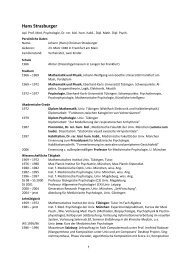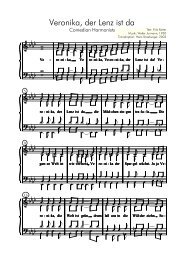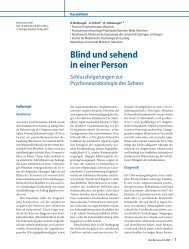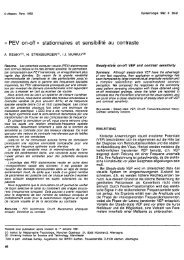Peripheral vision and pattern recognition: a review - strasburger - main
Peripheral vision and pattern recognition: a review - strasburger - main
Peripheral vision and pattern recognition: a review - strasburger - main
You also want an ePaper? Increase the reach of your titles
YUMPU automatically turns print PDFs into web optimized ePapers that Google loves.
<strong>Peripheral</strong>_Vision.doc<br />
Abstract<br />
We summarize the various str<strong>and</strong>s of research on peripheral <strong>vision</strong> <strong>and</strong> relate them to theories<br />
of form perception. After a historical overview, we describe quantifications of the cortical<br />
magnification hypothesis, including an extension of Schwartz’s cortical mapping function. The<br />
merits of this concept are considered across a wide range of psychophysical tasks, followed by<br />
a discussion of its limitations <strong>and</strong> the need for non-spatial scaling. We also <strong>review</strong> the<br />
eccentricity dependence of other low-level functions including reaction time, temporal resolution<br />
<strong>and</strong> spatial summation, as well as perimetric methods. A central topic is then the <strong>recognition</strong> of<br />
characters in peripheral <strong>vision</strong>, both at low <strong>and</strong> high levels of contrast, <strong>and</strong> the impact of<br />
surrounding contours known as crowding. We demonstrate how Bouma’s law, specifying the<br />
critical distance for the onset of crowding, can be stated in terms of the retino-cortical mapping.<br />
The <strong>recognition</strong> of more complex stimuli, like textures, faces <strong>and</strong> scenes reveals a substantial<br />
impact of mid-level <strong>vision</strong> <strong>and</strong> cognitive factors. We further consider eccentricity-dependent<br />
limitations of learning, both at the level of perceptual learning <strong>and</strong> <strong>pattern</strong> category learning.<br />
Generic limitations of extrafoveal <strong>vision</strong> are observed for the latter in categorization tasks<br />
involving multiple stimulus classes. Finally, models of peripheral form <strong>vision</strong> are discussed. We<br />
report that peripheral <strong>vision</strong> is limited with regard to <strong>pattern</strong> categorization by a distinctly lower<br />
representational complexity <strong>and</strong> processing speed. Taken together, the limitations of cognitive<br />
processing in peripheral <strong>vision</strong> appear to be as significant as those imposed on low-level<br />
functions <strong>and</strong> by way of crowding.<br />
Keywords: <strong>Peripheral</strong> <strong>vision</strong>, visual field, acuity, contrast sensitivity, temporal resolution,<br />
crowding effect, perceptual learning, computational models, categorization, object <strong>recognition</strong>,<br />
faces, facial expression, natural scenes, scene gist, texture, contour, learning, perceptual<br />
learning, category learning, generalization, invariance, translation invariance, shift invariance,<br />
representational complexity.<br />
1. Introduction<br />
The driver of a car traveling at high speed, a shy person avoiding to directly look at the object of<br />
her or his interest, a patient suffering from age-related macular degeneration, they all face the<br />
problem of getting the most out of seeing sidelong. It is commonly thought that blurriness of<br />
<strong>vision</strong> is the <strong>main</strong> characteristic of that condition. Yet Lettvin (1976) picked up the thread where<br />
Aubert <strong>and</strong> Foerster (1857) had left it when he insisted that any theory of peripheral <strong>vision</strong><br />
exclusively based on the assumption of blurriness is bound to fail: ”When I look at something it<br />
is as if a pointer extends from my eye to an object. The ‘pointer’ is my gaze, <strong>and</strong> what it touches<br />
I see most clearly. Things are less distinct as they lie farther from my gaze. It is not as if these<br />
things go out of focus – but rather it’s as if somehow they lose the quality of form” (Lettvin,<br />
1976, p. 10, cf. Figure 1).<br />
2






